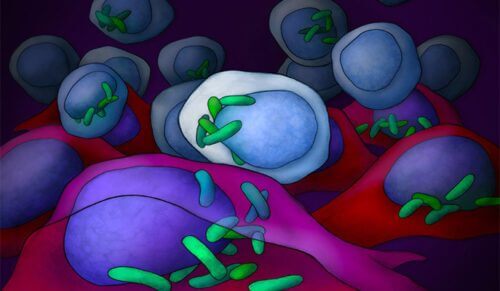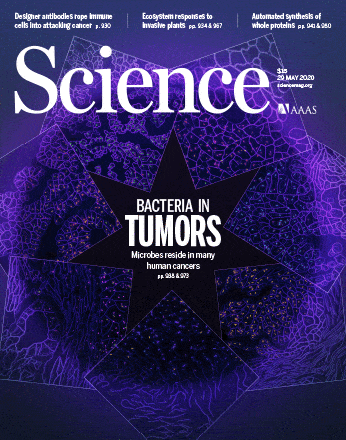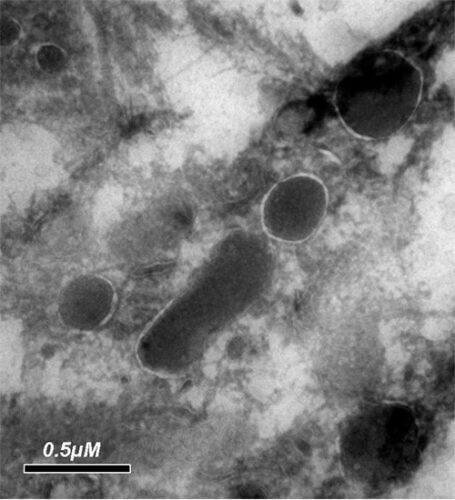Cancer cells are a convenient haven for bacteria. This is the conclusion derived from a comprehensive study by Weizmann Institute of Science scientists that was carried out on more than 1,000 tumor samples taken from humans. The researchers discovered living bacteria inside a wide variety of cancer cells - from bone cancer to skin cancer - and even identified bacterial populations unique to different types of cancer

Cancer cells are a convenient haven for bacteria. This is the conclusion derived from a comprehensive study by Weizmann Institute of Science scientists that was carried out on more than 1,000 tumor samples taken from humans. The researchers discovered living bacteria inside a wide variety of cancer cells - from bone cancer to skin cancer - and even identified bacterial populations unique to different types of cancer. The research shows that understanding the relationship between malignant tumors and the population of bacteria that characterizes them ("mini-microbiome") may help predict the effectiveness of anti-cancer treatments or indicate in the future ways to influence the bacteria in order to better fight the disease. The research findings were published in the scientific journal Science.
A few years ago, Dr. Ravid Straussman and research students in his laboratory in the Department of Molecular Biology of the Cell discovered bacteria residing inside pancreatic cancer cells in humans. These bacteria provided protection to the cancer cells against chemotherapy drugs by "digesting" the drugs and inactivating them. When additional studies reported bacteria inside cancer cells, Dr. Straussman's research group wondered if this might be the rule - and not the exception. To get to the root of the matter, Dr. Deborah Neuman and Dr. Ilana Levitan, from Dr. Straussman's laboratory, collaborated with Dr. Gary Fox, from the Department of Physics of Complex Systems at the Institute, with Dr. Noam Chantal, from the Department of Mathematics and Computer Science at the Open University, and with other oncologists and scientists from around the world. The result of this collaboration is a large-scale study that describes in detail the bacteria living inside tumor cells in a long list of cancer types: brain, bone, breast, lungs, ovaries, pancreas, colon and skin.

In all types of cancer tested, bacteria were found inside the cells, and more importantly - it was discovered that different types of cancer tend to host different species of bacteria. The largest and most diverse number of bacteria was discovered in breast cancer - and the researchers were even able to show that the bacteria clearly prefer the tumor tissue over the healthy breast tissue. Electron microscopy revealed that the bacteria tend to settle at a specific site within the cancer cells - near the nucleus.
The researchers discovered that the bacteria are hosted not only in the cancer cells, but also within the cells of the immune system residing in the tumors. "Some of these bacteria may suppress the body's immune response against cancer, while others may actually encourage it - this finding may be particularly relevant for predicting the effectiveness of immunotherapy treatments," says Dr. Straussman. Indeed, when the researchers compared the bacteria in melanoma samples, they discovered that different bacteria were found at higher levels in melanoma tumors that responded to immunotherapy treatment compared to tumors that did not respond to treatment successfully.

Dr. Straussman believes that in this research lies the beginning of an explanation for questions such as why certain bacteria like cancer cells and why each cancer has its own typical microbiome: "The differences probably boil down to the nature of the 'services' that the bacteria receive in different types of cancer. In other words, the bacteria may thrive as a result of certain metabolites that are produced in excess or tend to be stored in certain types of tumors." For example, the researchers found differences in the bacteria that lived in the lung tumors of smokers compared to the bacteria in the lung tumors of patients who never smoked. These differences were particularly striking when the two groups of bacteria were genetically mapped: the bacteria derived from the lung cancer cells of smokers had more genes related to the metabolism of nicotine, toluene, phenol and other chemicals found in cigarette smoke.
The researchers believe that the methods they have developed to identify a unique microbiome for each type of cancer will make it possible to answer crucial questions about the roles played by these bacteria: are they merely hitchhikers who live off the excess metabolites of the cancer cell or do they provide it with some service, at what stage of cancer development do they colonize the tumor , how do they promote or inhibit tumor development, and what are their effects on the response to a wide range of anti-cancer treatments? "Tumours are complex ecosystems, which include, in addition to cancer cells, also cells of the immune system, connective tissue cells, blood vessels and many other components, which together constitute what is known as the tumor microenvironment," says Dr. Straussman. "Our studies, as well as studies conducted in other laboratories, clearly show that bacteria are an integral part of this microenvironment. We hope that a better understanding of the bacteria's contribution to the microenvironment of the tumor will allow us to discover new ways to treat cancer."
More of the topic in Hayadan:

2 תגובות
wave
Interesting question.
He clearly has an interest in this.
Maybe cancerous tumors are like plant buds.
Perhaps in the future it will be possible to remove a bacterium from the tumor and genetically engineer it so that it secretes some toxin/medicine against the tumor. At the same time, give him immunity to some antibiotics and sensitivity to another. Then inject it into the tumor along with the antibiotic to which it is immune, and thus it will take the place of the other bacteria of its type, and then begin to secrete the medicine right inside the cells of the tumor, that way the bacteria can be a kind of guided missile into the tumor.
At the end of the treatment, the antibiotic that the bacteria is sensitive to should be given and thus eliminated after it has finished its function
Is it possible that the bacteria affect the cell and turn it into a cancerous cell?
Which can lead to a redefinition of cancer as a contagious disease also by bacteria and not only viruses such as the papilloma virus